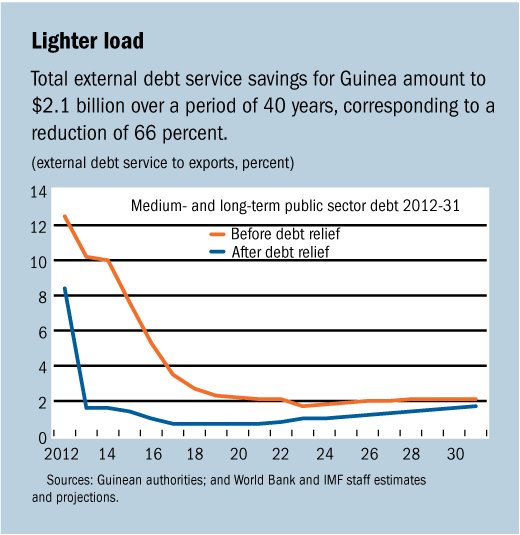DEBT RELIEF FOR AFRICA

Typical street scene in Santa Ana, El Salvador. (Photo: iStock)
IMF Survey: IMF, World Bank Support $2.1 Billion Debt Relief for Guinea
September 26, 2012
- Guinea's annual average debt service reduced by more than 60 percent
- Debt relief highlights progress in policy management, performance
- IMF urges structural reform to maximize benefits from expected mining boom
The IMF and the World Bank decided, on September 26 and 25 respectively, to support debt relief of $2.1 billion for Guinea.

Bauxite plant in Kamsar, Guinea where, amid rising investor confidence, large new projects are being developed, notably in mining sector (photo: Georges Gobet/AFP)
The Executive Boards of the two institutions agreed that Guinea had reached the final stage, or completion point, of the Enhanced Heavily Indebted Poor Countries (HIPC) Initiative. As a result, the west African country will benefit from debt relief under the HIPC Initiative and the Multilateral Debt Relief Initiative (MDRI), and from additional relief from bilateral creditors.
Total external debt service savings amount to $2.1 billion over 40 years, corresponding to a reduction of 66 percent. Multilateral creditors contribute 70 percent of the relief being provided, with the remainder coming from bilateral and commercial creditors. Debt relief provided by the World Bank’s International Development Association and the African Development Bank under the MDRI would save Guinea $964 million in debt service over 40 years (see chart).

Debt indicators
Guinea’s debt indicators will improve substantially as a result of the move. The ratio of the present value of future debt service to GDP will fall from about 50 percent at end-2011 to 13 percent at end-2012; and the ratio of the present value of future debt service to exports will be reduced from 186 percent to 49 percent, respectively, for the two periods. Guinea’s graduation under the enhanced HIPC Initiative brings to 34 the number of countries that benefited from its debt relief (see box).
The thirty-four
Afghanistan
Benin
Bolivia
Burkina Faso
Burundi
Cameroon
Central African Republic
Republic of Congo
Democratic Republic of Congo
Cote d’Ivoire
Ethiopia
The Gambia
Ghana
Guinea
Guinea-Bissau
Guyana
Haiti
Honduras
Liberia
Madagascar
Malawi
Mali
Mauritania
Mozambique
Nicaragua
Niger
Rwanda
São Tomé and Príncipe
Senegal
Sierra Leone
Tanzania
Togo
Uganda
Zambia
To reach the completion point under the HIPC debt relief initiative, Guinea had to meet specific targets relating to poverty reduction, macroeconomic management, and institutional reforms.
• Poverty reduction: preparation of a poverty reduction strategy in a participatory process, and satisfactory implementation of that strategy for at least one year
• Macroeconomic stability: good performance under the economic program being supported with financing under the IMF’s Extended Credit Facility
• Transparent governance: publication of annual reports of the anti-corruption agency and of audit reports of large government procurement contracts; and
• Improvement in the education and health sectors: the hiring of additional teachers and achievement of targets regarding children immunization and prenatal care.
“Reaching the HIPC completion point represents an important achievement for Guinea. It reflects the significant progress made in economic management following the first democratic elections in December 2010. The resulting debt relief will provide Guinea more resources for poverty reduction and economic growth,” said Harry Snoek, IMF mission chief for Guinea.
Engagement with the IMF
The IMF and World Bank Boards declared in December 2000 that Guinea was eligible under the HIPC Initiative (the decision point). However, attainment of the final stage of the HIPC process, the completion point, was repeatedly delayed, mainly by political crises and weak economic management.
Guinea’s performance under IMF-supported programs was mixed until the first democratically elected government took office in 2011. An SMP covering 2011 was satisfactorily implemented, paving the way to a program supported under the Extended Credit Facility, approved in February 2012 and covering the period 2012–14.
Building on the mining boom
Guinea has abundant natural resources and enormous potential in agriculture, mining, and hydroelectricity. The strong macroeconomic policies and structural reforms initiated in 2011 have contributed to improving investors’ confidence and large new projects are being developed, notably in the mining sector.
It will be important to consolidate recent gains in macroeconomic stabilization and to avoid the policy reversals seen in the past. Structural reforms will be key to ensuring that the expected mining boom results in broad-based economic growth and poverty reduction. Such reforms should include strengthening governance in the mining sector, providing sustainable support to the agricultural sector, improving delivery of electricity and financial viability of the electricity company, and, more generally, improving economic governance and the business climate.
“Sound macroeconomic management will remain critical after the completion point to provide an enabling environment for growth, both in the mining and non-mining sectors. The authorities should adopt cautious debt management and policies to avoid falling back into debt distress,” Snoek said.







